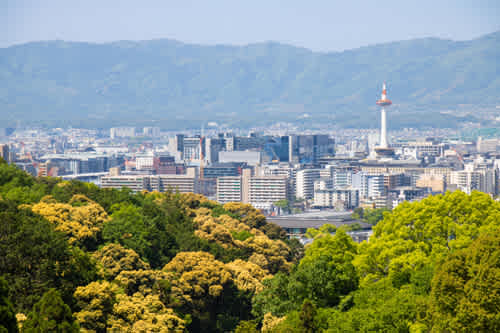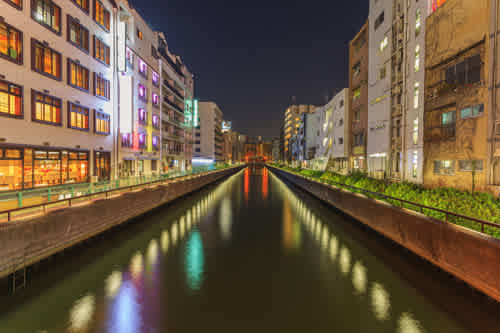Kyoto, known as Japan's cultural center, is a place where ancient shrines, serene gardens, and historical districts blend with modern Japanese sophistication.
About Kyoto
It is a city steeped in history and tradition.
Having served as Japan's capital for over a thousand years, Kyoto remains a repository of cultural wealth and architectural wonders. From the blossoming cherry trees in spring to the breathtaking autumn foliage, the city radiates charm in every season. The harmonious blend of tradition and innovation offers a multifaceted experience for visitors seeking to enjoy Japan's wonderful heritage.
Here are some recommended sites to visit:
Castle Nijo, a UNESCO World Heritage site, is a symbol of the city’s historical heritage. Built in the 17th century, the castle is considered an architectural gem with its "nightingale floors" that chirp when walked upon, reminiscent of Japan's feudal past. The castle complex includes majestic gates, impressive gardens, and a palace featuring luxurious rooms and historical artifacts. The castle's gardens showcase stunning garden architecture, including ponds, bridges, and meticulously maintained greenery, as is traditional in Japanese gardens.
Kyoto Imperial Palace is the former residence of the imperial family. Access to the traditionally designed palace is available through guided tours only. The palace gardens are meticulously designed, incorporating elements of traditional Japanese design, including ponds, bridges, and characteristic vegetation.
The Philosopher's Path is a scenic trail along the canal. Adorned with blooming cherry trees in spring, the Philosopher's Path provides an ideal setting for contemplation and relaxation. Named after a philosopher who used to walk here, it is now a beloved spot for locals and visitors seeking a calm respite from the city's hustle and bustle.
The gently swaying bamboo shoots in the Arashiyama Bamboo Grove create a breathtaking landscape, forming a tranquil corridor of natural beauty. Sunlight filtering through the dense canopy creates a serene atmosphere, and the rustling leaves add a touch of musical harmony to the surroundings. It's a sensory voyage that whisks visitors away to a dreamlike realm, where the soothing ambiance and regal greenery provide a truly enchanting experience. While strolling through the winding paths of the forest, the towering height of the bamboo shoots adds an almost mystical touch.
Fushimi Inari Shrine is famous for its thousands of vibrant orange Torii gates stretching along the picturesque hillsides. Dedicated to Inari, the Shinto deity of rice, fertility, and prosperity, the shrine offers a fascinating and spiritual journey along its trails. Visitors can stroll through the Torii gates, wander through thick vegetation, and enjoy occasional panoramic viewpoints of the city. With its mystical atmosphere and unique illumination, the shrine is a testament to Japan's rich spiritual heritage and natural beauty.
The Heian Shrine, established in 1895 to celebrate Kyoto's 1,100th anniversary, boasts stunning Torii gates and expansive grounds. The complex includes a magnificent main hall and large, picturesque gardens designed to reflect the aesthetic of the shrine.
Byodo-in Temple is a UNESCO World Heritage site, and its refined wooden structure, adorned with an image of Japan's 10-yen coin on one side, showcases remarkable architecture. The temple gardens and pond create a picturesque and serene experience.
Kinkaku-ji, also known as the Golden Pavilion, features upper floors embellished in gold, casting a reflection in the serene waters of the Kyoko-chi pond and resulting in a mesmerizing sight. This Buddhist temple showcases refined architectural styles spanning three floors, each representing distinct periods in Japanese history. Recognized as a UNESCO World Heritage site, it is surrounded by meticulously designed gardens.
Ryoan-ji Temple is renowned for its Zen rock garden, emphasizing simplicity and tranquility. The garden, a masterpiece of design, features fifteen rocks carefully placed amidst raked gravel against the backdrop of the temple. Beyond the garden, the temple grounds offer ponds and enchanting views, complementing the spiritual atmosphere of this UNESCO World Heritage site.
Tofuku-ji Temple, a Zen temple, is known for the breathtaking autumn foliage in its stunning gardens.
Otagi Nenbutsu-ji Temple includes a collection of over 1,000 lively stone sculptures, each with a unique expression, creating a distinctive atmosphere throughout the temple gardens.
Kyoto International Manga Museum is a culturally unique experience. With an extensive array of manga (Japanese comics and graphic books), it welcomes visitors to delve into thousands of volumes, offering insights into Japan's diverse comic art. The open shelves and reading spaces create a lively atmosphere, enabling enthusiasts and inquisitive visitors to immerse themselves in the manga world, spanning genres from action, fantasy, and romance to historical dramas and science fiction.
The Kyoto Railway Museum is a popular attraction for train and locomotive enthusiasts, showcasing everything from vintage trains and cars to high-speed trains, along with fascinating exhibitions detailing the evolution of Japan's railways. Visitors can explore restored train carriages, operate train simulators, and learn about the technological advancements in the country's transportation.
The Kyoto National Museum is a cultural treasure, preserving Japan's artistic heritage. Displaying an extensive collection of traditional and contemporary art, from ceramics to textiles and historical artifacts, the museum provides profound insights into Japanese heritage. Its seasonal exhibitions frequently center around thematic and cultural significance, presenting exceptional art with deep cultural meaning. With a rich blend of permanent and rotating exhibitions, this museum serves as a gateway to Japan's history, art, and cultural evolution, inviting visitors to delve into Kyoto's cultural heritage.
The Kyoto Handicraft Center showcases shops with traditional crafts, giving visitors a glimpse into the intricate process of creating handcrafted pottery, textiles, lacquerware, and other treasures. It is a great place to purchase unique and authentic souvenirs, appreciating the skill and artistry behind each creation.
Known as Kyoto's culinary pantry, Nishiki Market is a lively destination with vibrant stalls offering local delights and culinary treasures. Dubbed the "Kitchen of Kyoto," this market presents a variety of fresh seafood, traditional snacks, pickles, sweets, and fresh produce. The visit is a sensory experience, where enticing aromas and colorful displays enchant visitors to taste diverse Japanese flavors and savor the city's culinary heritage.
Cuisine
Tea Ceremony: Participate in a traditional Japanese tea ceremony and experience the rituals and cultural significance of matcha tea.
Kaiseki Ryori: Kaiseki Ryori is known for meticulously presenting multi-course meals with seasonal ingredients. It is an artistic and refined dining experience, often served in a variety of beautifully adorned ceramic dishes.
Obanzai Ryori: This is home-style cooking with a focus on local and seasonal ingredients, featuring various small dishes meant for sharing.
Matcha Sweets: Kyoto is renowned for producing matcha (green tea). Indulge in matcha-flavored treats such as matcha ice cream, matcha cakes, and traditional wagashi (Japanese sweets).
Kyo-tsukemono: These Kyoto-style pickles have subtle flavors and are often served as accompaniments to meals.
Yuba: These thin layers of tofu skin are served in various ways, such as in soups, salads, or hot pots.
Soba and Udon Noodles: While not exclusive to Kyoto, the city offers its unique recipes for soba and udon noodles, often incorporating local ingredients.
Popular Itineraries
Traveled by thousands
Kyoto Hotels
by

Looking for some interesting things to do in Kyoto? Here are some recommended attractions and sights for you.
food & drink
tours, sightseeing & cruises
Attractions in Kyoto
- Adashino Nenbutsuji Temple, Kyoto
- Daigoji Temple, Kyoto
- Daitokuji Temple, Kyoto
- Enryakuji Temple, Kyoto
- Fushimi Inari Taisha, Kyoto
- Ginkakuji (Silver Pavilion), Kyoto
- Gion District, Kyoto
- Heian Shrine, Kyoto
- Historic Center, Kyoto
- Katsura Imperial Villa, Kyoto
- Kinkaku-ji, Kyoto
- Kiyomizudera Temple, Kyoto
- Kodaiji Temple, Kyoto
- Koryuji Temple, Kyoto
- Kyoto Imperial Palace
Voice guided walking tours give you the freedom to explore at your own pace. You can start walking at any time and stop whenever and wherever you like, for as long as you like. For RoutePerfect customers with our partner VoiceMap's mobile app.








 Travel Perks
Travel Perks 



